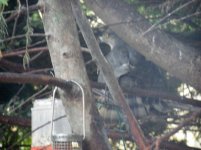I know reviving an old thread is usually frowned upon (it's called Necromancing), but there's been quite a change in tactics in my garden.
A bit of background information might help:
Over the last few months I've only seen a Sparrowhawk a few times, and only seen one kill (a juvenile Starling, picture posted in my gallery). However, I have heard the aftermath of an attack many times during the same period, and I've heard the unmistakeable screech of a Starling being attacked a few times as well. In fact I've had about the same amount of birds panicking and flying into windows, birds' frantic alarm calls, and screeching Starlings, as I'm used to over the last couple of years. The puzzling thing was, I've hardly seen any Sparrowhawks. This confused me more because there were, and still are, over 30 juvenile Sparrows, and well over 30 juvenile Starlings. Add to this the other birds (40+ Pigeons, between 8 and 16 Collard Doves, adult Starlings, Adult Sparrows) in my garden and you get a great deal of potential prey in a small area (roughly 20 feet square).
Well, about half an hour ago I was cleaning up the garden, as I do every night. This is a bit of a ritual, as I feed the Pigeons by hand while cleaning up (they started it, not me). So while I'm cleaning up, the garden is full of birds and the trees are full of Sparrows, Starlings, and a few Collard Doves. All of the birds are used to this ritual, and have no fear of me. Suddenly, above the noise of the Starlings, I heard a noise like a gust of wind, and all of the birds panicked and flew off. The Sparrows' alarms were almost deafening, but I could see nothing. As I was under the trees at the time, I looked up, and high up in the tree was a Sparrowhawk. So I've been thinking about it, and I think I've worked out what's happening, and why.
Two things are different in my garden this year: there are more juveniles, and my trees have grown outwards.
My garden almost has a roof of tree branches, there's only a few feet clear near the fence. The Sparrowhawks have lost their usual attack route as the branches get in the way. It would mean avoiding the neighbours washing lines, flying down sharply, then under the branches to get to the birds; so the birds get more chance to escape from the trees. If birds are on the ground they are almost completely protected by branches that weren't there over the last few years.
Also, because there are so many juveniles they can't all get to the feeders at the same time. When there were less birds they would wait near the feeders while others fought it out. But there's no room now, so many birds wait higher up in the trees and drop down as others move to the apples on the floor or to the bird baths.
This has meant that the only reasonable approach for the Sparrowhawk is to take the birds that are higher up in the trees. That way, there is a direct route from where it's hiding to the many birds high up in the trees. And that's what I think has been happening for the last few months. The reason the Sparrowhawks aren't eating their kill in my garden is too many overhanging branches; they like cover, but they also like a clear view of at least a couple of angles.
So, if I'm right, the balance has shifted in favour of the prey. Now that's good for the prey (unless they starve to death) but bad for the Sparrowhawks.
So what do I do? If I cut back the branches I'd be interfering with Nature, but if I do nothing there could be both starving prey and starving predators. I'm hoping the Sparrowhawks will work it out; I'm sure the situation isn't totally unique.
For now I'm just going to watch and try to confirm what is happening.





